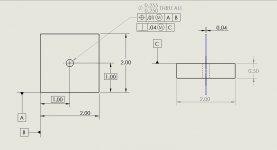sendithard
Plastic
- Joined
- May 18, 2021
In the below sketch I'm showing a large .500" GD&T positional tolerance zone for clarity. In reality, I understand this would be something like .01". The .250" circles would be drilled hole locations. If one drills a hole at the extreme allowable distance from true position does one get the same perpendicularity tolerance zone as you would if you drilled anywhere else? So basically, I'm asking if this tolerance zone 'wrapper'(.04" in the picture) travels with your hole location? I'm curious if the perp tolerance would just be large like around .05" and tied down to the true position location and just stays there.





